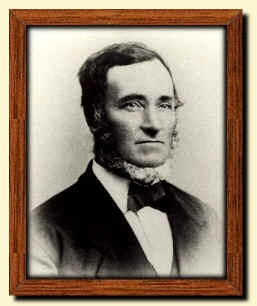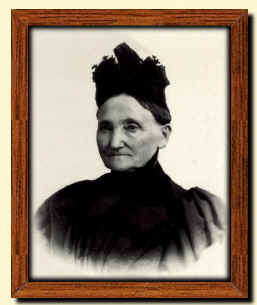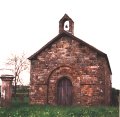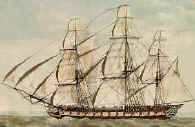Thomas Relph, Emigrant to America 1849 By Susan L. Harnwell |
|
 |
 |
Thomas Relph, Emigrant to America 1849 By Susan L. Harnwell |
|
 |
 |
In the fall of 1849, Thomas Relph was 25 years old. Along with his wife, his infant son, and his younger brother, John, he left the parish of Wigton in Cumberland, England, forever and sailed to America.
Thomas was the descendant of farmers and blacksmiths, and his family had lived in Cumberland for a number of generations, working on the sheep and cattle farms that still fill the coastal land just south of the Solway Firth. At this time, the four generations preceding Thomas are documented.
The earliest place associated with our Relph Family is a large farm called Priour Hall, in Ireby Parish, Cumberland. In the Middle Ages, the Priour Hall farm belonged to the Carlisle Priory and provided food for the community of monks located there. Members of a Relph family already lived and worked as tenant farmers at Priour Hall in the early 1600’s when it was managed by one George Crage, Gent. Although it is reasonable to assume that those early Relphs were ancestors of our family, the proof is missing at this time.
The earliest Relph ancestor who is currently documented is William Relfe who was born about 1712. It is not known exactly where William was born. In any case, on the 6th of October 1737, he married Elizabeth Dann at the old Ireby parish church. Today, only the chancel of this 12th century church remains intact. Although no longer in use, the small church is maintained by the British Redundant Churches Fund. It is located about a quarter of a mile from the Priour Hall farm which is still a working sheep farm. It is reasonable to speculate that William was a nephew or cousin of the Relphs then living at Priour Hall and may have come to Ireby parish on an offer of work from his family. William and Elizabeth Relph lived at Priour Hall where their son, George, was born. So far, no other children have been documented for William and Elizabeth, and William was buried at the old Ireby parish church on April 8, 1752.
| George Relph, son of William and Elizabeth, was baptized at the Ireby parish church on April 20, 1738, and undoubtedly grew up learning all aspects of agriculture on Priour Hall farm. George was 14 when his father died. With no husband working on the farm, Elizabeth would have had a very difficult time. And it is probable that son George took over the position of family bread winner. To date, no record of Elizabeth’s death has been found. |  |
When he was 18 years old, George married Thamar Grave on July 29, 1756. Thamar was 17 and the daughter of Joseph Grave of Plumbland parish, where she was baptized on September 30, 1739. George and Thamar were married in Torpenhow parish. Since the bride and groom were both under age, the marriage record shows that they married "with consent" of their parents. Clearly George had meanwhile convinced the owners of Priour Hall that he was indeed of an age to do a man’s work. So he took his young bride home to Priour Hall, and not quite a year later their first child was baptized in the Ireby parish church.
Over the years, George and Thamar had 16 children. In an age when few children survived and mothers often died bearing them, George and Thamer and their whole brood were apparently of very robust health. The records would indicate that all their children grew to adulthood, and George and Thamer both lived into the next century. Through the many entries in the Ireby baptismal record, George is described variously as being an "Estatesman" and "Husbandman" in his children’s baptismal records. By 1774, George had become the "Yeoman Farmer" of Priour Hall. As the "Estatesman" he was managing Priour Hall for someone else. When he became a "Yeoman Farmer", it meant that he had acquired the Priour Hall land which he worked. Within the framework of his times, George was a very successful man.
Sometime after the birth of their last child in 1785, George, Thamer and most of their family left Priour Hall and moved north to Holme Cultram parish. It is noted that one of their daughters married a Holme Cultram man in 1792. Perhaps they decided then to go live near their daughter. It should also be noted that the continuing Enclosure Acts of Parliament made life very difficult for the Yeoman Farmers, and possibly it became economically impossible to continue at the Priour Hall farm. Whatever the reason for their move, George and Thamer both died in Holme Cultram parish. They had been married for 63 years when Thamer was finally buried in the Holme Cultram Abbey church yard on July 17, 1819, at the age of 79. George outlived his wife by more than nine years, and was buried beside her on October 22, 1828. At a time when life expectancy was 45 to 50 years, George lived to be 91 years old. Their gravestones stand side-by-side in the Abbeytown churchyard. By any measure of their times, they were quite exceptional people.
The next of our ancestry was Thomas Relph, the elder, who was born in December 1774 at Priour Hall in Ireby Parish. He was the 5th son and eleventh child of George Relph and his wife, Tamer. Thomas most certainly learned his trade on his father’s farm. He was a "black and whitesmith". This means that he was not only responsible for forging the iron, but he was also entrusted with the polishing and finishing of the implements – a job requiring a higher level of skill. When his family dispersed from Priour Hill farm, Thomas eventually found work in the Waverton farm community in Wigton parish.
On November 13, 1798, Thomas Relph married Mary Barnes at the parish church in Wigton. Thomas was 25, and Mary was 30. They returned to the Waverton farm community, and a short four months later their first son was born – John Relph was baptized at the Wigton parish church on March 25, 1799. Sometime in the following year or two, Thomas and Mary moved to the Akebank community, still within Wigton parish. Their next three children were born in Akebank before they moved into the town of Wigton itself about 1813. In all likelihood, a fifth child remains undocumented, but their last and probably sixth child was born in Wigton.
Wigton had a thriving economy at that time and had developed a flourishing economy based on the cloth trade when Thomas moved his family into the town. He was one of eight blacksmiths serving the needs of a growing town. Thomas lived the rest of his life in Wigton where he died at the age of 60 and was buried on Christmas Day 1834.
At the time of his father’s death, John Relph was 35, and a married man with four of his own children. While growing up, he learned his father’s blacksmithing trade. It is reasonable to speculate that as an adult John shared premises with his father in the Wigton blacksmith business. About the same time as his father died, the records show that John left Wigton and moved his family to the Seaville farm in Holme Cultram parish. The Wigton economy was beginning to decline by this time, and the need for blacksmiths may have waned. In any case, John took a position as the blacksmith at Seaville farm.
Twelve years prior to his father’s death, John Relph had married Ann Hall on June 18, 1822. Ann was baptized on June 26, 1800, the daughter of Joseph Hall, a shoemaker in Wigton, and Margaret Richardson. John was 23 and Ann was 22. Their first child, Thomas Relph (the Emigrant) was born in Wigton on January 13, 1824. In the traditional way, John named his first son after his own father, the elder Thomas Relph. Three more of their children were also born in Wigton – John, Jr., who would later go to America with Thomas, and Joseph, and Margaret. After the move to Seaville in Holme Cultram, the last three children – Isaac, Henry and Ann -- were born and baptized in the old Abbey church which served there as the local parish church.
Although the local economy was generally in decline, the cloth trade was still a lucrative business in the Wigton area. As a result, Thomas was apprenticed to a tailor. In the summer of 1841, John, Sr. and the family lived and worked at the Seaville farm. Son Thomas was 15 and learning the tailoring trade under the watchful eye of one William Osborne in Abbeytown, about four miles east of the farm. As it turned out, only one of John Relph’s sons – John, Jr. – followed the blacksmith trade of his father and grandfather. Thomas and his other two brothers, Isaac and Henry, were all eventually apprenticed as tailors.
 |
The Seaville farm still exists today, growing a grain crop. In all
likelihood, it is part of some large agri-business conglomerate, and most of the buildings
look quite modern. Abbeytown is still essentially a small farming village with only a few
more houses than it had when our Relphs lived there. In March of 1844, tragedy stuck the Relphs of Seaville, Holme Cultram. John Relph, Sr. died young and unnecessarily, leaving his widow and six children without a major bread earner. The coroner’s report shows that he died "by starvation from Exposure to Cold and Excessive Drinking." The story is recorded in the Coroner’s Deposition Book, as told by three of John’s neighbors. |
Nicholas Littleton of Swinston says: On Friday night about 9 o’clock, I met the deceased in the Abbey Lane on the west side of the gate leading to John Mann’s second field in the road. This would be about one-quarter mile from the place he was found. First, when I saw him he was lying near the gutter. I asked him if he was fir to go home. He said the thought he was. He appeared to be rather tipsy. He got up again and walked steadily away. He was lying his full length upon the ground. After I parted with him I heard him calling out as if he was hunting. He was in good spirits. I offered to go home with the deceased, but he refused to allow me.
Another neighbor, Thomas Brown, found him early Saturday morning, and gives the following report: About six o’clock on Saturday morning last, I found deceased lying in a ditch in Brownrigg Lane. He was lying on his side and his legs were in the water. He was breathing. He was in a state of stupor and quite insensible. His eyes were open and fixed in his head. His face was white, very pale. I removed him from the water and went for Mr. Peat. I went back again and he was taken home. When I found him there were the appearances of the Deceased having struggled a great deal – there did not appear to be the foot marks of any other person near the place. There was snow upon the ground. His hat was off, lying near him. There were no marks of violence on his body.
Robert Peat, who was summoned by Thomas Brown to help, recounts the following: I was told by Mr. Brown that the Deceased was lying in the road a short distance from my home. I went with him and found the Deceased as described by Mr. Brown. I assisted to carry him home. We laid him before the fire and used every means for his recovery that we could think of.
Dr. Maling was sent for. Deceased died about 6 o’clock at night on Saturday. (March 18, 1844) There were no marks of violence on deceased’s body, excepting a small thorn scratch upon his neck. On the preceding Friday night I was with Deceased at Abbeytown. We were in two public houses there.
Deceased had been drinking all Friday. Deceased and I left the Abbey together. I was on horseback. I requested Deceased to get on behind me. He jumped upon the pony’s neck, and the pony became restive. He then refused to get up on the pony. We came on together a short distance, and I again asked him to get on my horse, but he refused, saying he was pretty strong. He was better on foot. He was tipsy. I then left him and proceeded home. This would be about 9 o’clock. The weather was excessively cold and frosty.
One can only imagine the hardship John Relph’s death created for his family. Our ancestor, Thomas the Emigrant, was 20 years old and probably earning a small wage. But it is most likely that John, Jr., who was then 18, took over his father’s position as the blacksmith at Seaville farm, thus enabling the family to continue living there as the record shows they did.
During this period, the non-conformist churches were very active as a reaction against the established Church of England. The history of the area shows that the Wesleyan Methodists had several congregations around where the Relph family lived. According to his obituary, Thomas Relph converted to Methodism at the age of 22, in 1846. One can only speculate to what extent the tragic death of his father influenced or prompted this decision. Whatever the reasons may have been, Thomas Relph remained a very devout and practicing Methodist to the end of his life.
Sometime in about this period, Thomas Relph met Anne Reay. She was the daughter of John Reay and Sarah Mann of Raby farm in Holme Cultram parish, and the Granddaughter of Matthew Mann of Bromfield. Raby farm is also still a working farm about a mile north of Abbeytown. Anne was trained as a seamstress, and it is reasonable to think that they met through their work. However, it was Thomas’ younger brother, John, Jr., who was the first of the family to marry in the Abbey church on October 2, 1846, a month after the baptism of his first child.
It is worth noting here that this sequence of events is not that unusual in 19th century England. Marrying in Church of England required the payment of a substantial fee, and many people simply did not enjoy the financial conditions which would make this immediately possibly. Although Thomas had converted to Methodism, most non-conformists still went to the Church of England for "official" events since the non-conformists records were not recognized as "legal". Thomas and John were certainly both helping to support their widowed mother and younger siblings and would have had to save for some time in order to be able to pay this fee. It is interesting to speculate on the family discussions which must have taken place when it became apparent that John’s fiancee, Jane Scott, was expecting. And it would appear to have taken some time to get the fee together.
Over a year after his younger brother’s wedding, Thomas Relph married Anne Reay on November 27, 1847, in the Holme Cultram parish church. Thomas and Anne were both 23 years old. Almost exactly a year later, their first child was born on November 10, 1848 at the Seaville farm and baptized John Relph, after his ill-fated grandfather in accordance with the naming traditions of the times.
Sometime after the birth of their son, Thomas and Anne made the decision to emigrate to America. And Thomas’ younger brother John, the blacksmith, decided to join them. Or perhaps it was John who first decided. From this distance in time, it is impossible to say what prompted them to leave their homes forever in 1849 and take their families to the new world. John’s wife, Jane, had had their second child in February that year. Thomas’ wife, Anne, was already expecting their second baby when the two families went on board ship that fall, very likely in Liverpool. They never saw England again.
The widow, Ann Relph, appears to have left the Seaville farm at the time her two eldest sons departed for America. There was no longer a blacksmith in the family to justify living on the farm; or perhaps the job had been discontinued. The family moved back to the town of Wigton, and the third son, Joseph, a tailor, married Mary Peat in the Wigton parish church on February 8, 1850.
In the spring of 1851, the widow Ann Relph was 52 years old and earning her living as a "needle woman". Her two remaining sons, Isaac and Henry, were 17 and 14, and both were apprentice tailors. They lived with their mother on Market Hill in Wigton. Daughter Margaret was 19 and employed as a live-in servant in the house of one Joseph Carrick, a prominent solicitor (lawyer) in Wigton. The records show that she was a "nurse". The Carricks had a toddler and an infant, and most likely Margaret was employed to look after the children. The baby of the Relph family, Ann, was 10 years old and also working as a live-in servant in the home of Mrs. Drape, a widowed librarian in Wigton. It was a small town, and the remaining family all lived within a few minutes walk of one another.
In the following ten years, Margaret married John Gill, a railway guard, in 1854, in the parish of Preston in Lancaster. They had two sons and a daughter. Isaac had already married and become a widower when he married his second wife in 1859 in Wigton. It would appear that Henry went to Preston, Lancaster, with his sister; he married Emma Sanderson there in 1861. Henry returned to Wigton where his infant daughter died in 1868. Tragedy befell the family again when Margaret’s husband died, probably in a railway accident, about 1859. She returned to Wigton with her three small children to live with her mother and unmarried sister, Ann, on Water Street in Wigton in 1861. At this time, nothing further is known of the family that Thomas Relph left behind when he went to America.
Meanwhile, Thomas and John had arrived in America. During the long sea voyage, Anne’s second baby had been born and died at sea. They had named her Sarah. It is not yet known exactly when or where Thomas, John and their families arrived in America.
John was living in upstate New York in Onondaga County, by the summer of 1850. Later, John fought with the 122 NY Volunteer Infantry in the American Civil War and had numerous descendants. Thomas lived in Sennett, NY, in Cayuga County, where he would spend the rest of his life.
 |